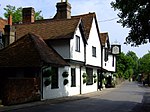Hurley Priory
1086 establishments in England1536 disestablishments in EnglandBenedictine monasteries in EnglandBerkshire building and structure stubsBuildings and structures in the Royal Borough of Windsor and Maidenhead ... and 8 more
Christian monasteries established in the 11th centuryChurch of England church buildings in BerkshireDe Mandeville familyEnglish church stubsHistory of the River ThamesHurley, BerkshireMonasteries in BerkshireUse British English from May 2017

Hurley Priory is a former Benedictine priory in the village of Hurley. Founded in 1086, the remains are located on the banks of the River Thames in the English county of Berkshire.
Excerpt from the Wikipedia article Hurley Priory (License: CC BY-SA 3.0, Authors, Images).Hurley Priory
High Street,
Geographical coordinates (GPS) Address Nearby Places Show on map
Geographical coordinates (GPS)
| Latitude | Longitude |
|---|---|
| N 51.5496 ° | E -0.8097 ° |
Address
St Mary The Virgin
High Street
SL6 5NB , Hurley
England, United Kingdom
Open on Google Maps










